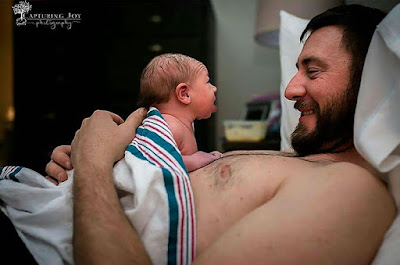Preparing
Dad for the labour ward
When I trained to become a midwife
in the mid-’70s, dads-to-be walked up and down in the corridors or smoked in
the waiting room while everything happened behind closed doors in the delivery
room. Once mom had recovered and was spruced up and the baby had been bathed and
swaddled into a bassinette in the nursery, Dad was given a peek at his
offspring through a big glass nursery window and then allowed to give his wife
a bunch of flowers. It was all very formal.
Luckily this had all changed by the time I had my first baby, and because I knew what to expect, I could talk my
man through what was going to happen next. A few years later when I started
giving pre-natal classes, I realised that it was just as important to prepare
men for the labour room as it is to prepare women.
I can’t claim to be the instigator
of educating couples. This had all started in the early 1940s when Dr Grantly
Dick-Read published his book “Childbirth without fear” stressing that
childbirth is natural and that pain is minimised when fear is taken away. This
research was followed by the French obstetrician, Dr Ferdinand Lamaze and American
obstetrician, Dr Robert Bradley. Only then, with much negotiating and the
support of midwives and parents, maternity units opened their doors to men who
now play ‘doula’ during the first stage, help his woman to focus during the birth
and share the joy in the first ‘magic hour’ together. Some private midwife-run
facilities go so far as to provide a double-bed for couples in their own
private suite where they do everything for themselves with midwives on standby
should they need help.
The move towards women choosing to
start a family when she is older, escalating fertility treatments plus doctor’s
fear of litigation when there are (even minor) complications has meant more
c-sections (especially private health care). This also means that women (and
their doctors) don’t feel the need for physical preparation before the birth –
just as long as she knows how to cope with major abdominal surgery after the
birth.
Where does this leave Dad? To be
honest – pregnancy, babies and birth belong in the women’s department. Men learn
to cope with pregnancy-related outbursts and emotional melt-downs, but when it’s ‘crunch
time’ ie time to go to the hospital, reality hits them between the eyes like a
punch ball. They’re not quite sure where to look or what to say or do. While
some feel like obscure spectator’s, others jabber on with the nervous conversation
or get in the way with cameras and video equipment. A few simply pass out. But
they all feel drained and exhausted afterwards, wondering what just happened,
how their lives have changed and what they can do to cope.
Top tips for dads:
- Join in with prenatal classes where there is an opening for dads
- Go with your partner to the doctor/midwife as often as you can – or at least for the first visit, the first scan, the hospital ‘tour’ and her last few appointments when she really needs your support, and you have the opportunity to ask questions
- Read that parenting and baby magazines she conveniently leaves lying around
- Work on baby’s room together and talk about how you are feeling
- Talk to seasoned dads – and learn from their mistakes.
Like the picture? I found it on
“100 powerful photos of dads in the delivery room to celebrate Father’s Day”.
Open the website for more.



